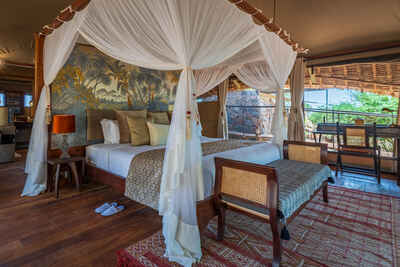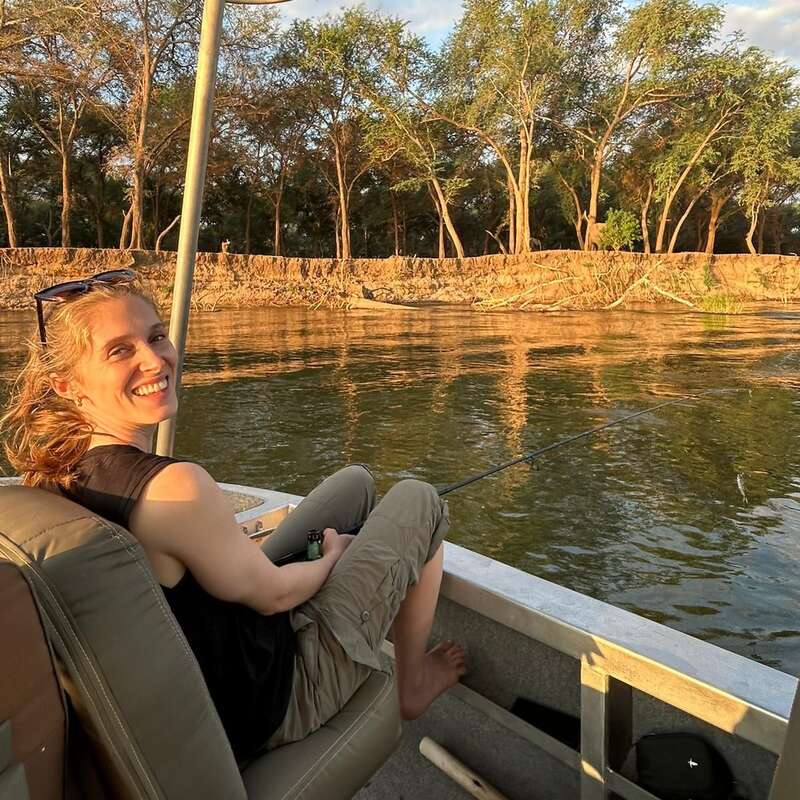About Larsens Tented Camp
One of a handful of tented camps along the north bank of the Ewaso Nyiro river, Larsen's is well placed to ...
... provide reliably good game-viewing in the dry country of Samburu National Reserve.
The Larsen's team was one of the most friendly and efficient that we have met in Kenya and the atmosphere was very laid-back and unpretentious. We found the guiding here superb, and the riverine forest location, with abundant birdlife, monkeys, and large mammal visitors, is very appealing. These aspects, combined with the camp's high-quality refurbishment, make it a very comfortable base from where to explore the surrounding Samburu ecosystem.
Our view
The Larsen's team was one of the most friendly and efficient that we have met in Kenya and the atmosphere was very laid-back and unpretentious. We found the guiding here superb, and the riverine forest location, with abundant birdlife, monkeys, and large mammal visitors, is very appealing. These aspects, combined with the camp's high-quality refurbishment, make it a very comfortable base from where to explore the surrounding Samburu ecosystem.
Accommodation
20 tented rooms
Children
Fine for 5+
Open
All year
Activities

4WD Safari

Birdwatching

Private activities
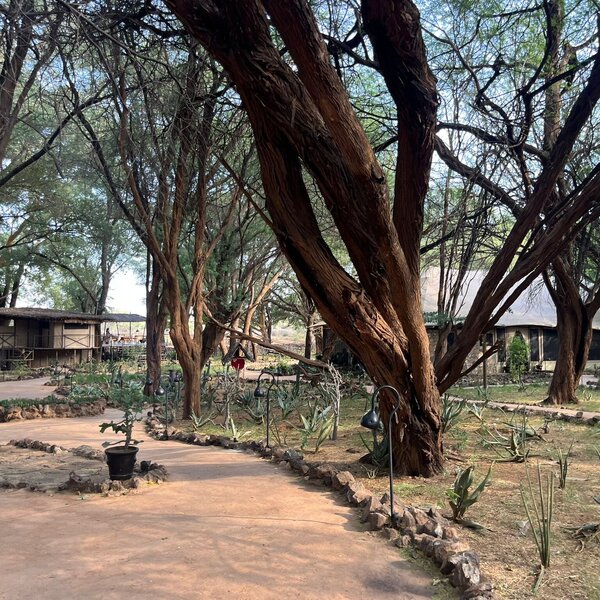
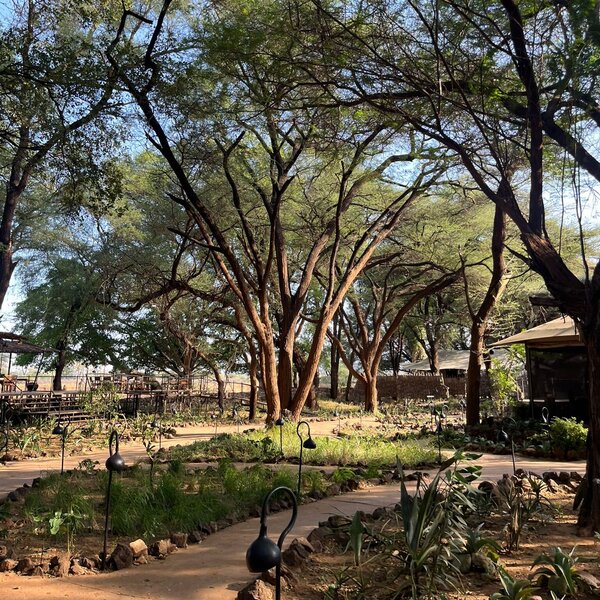
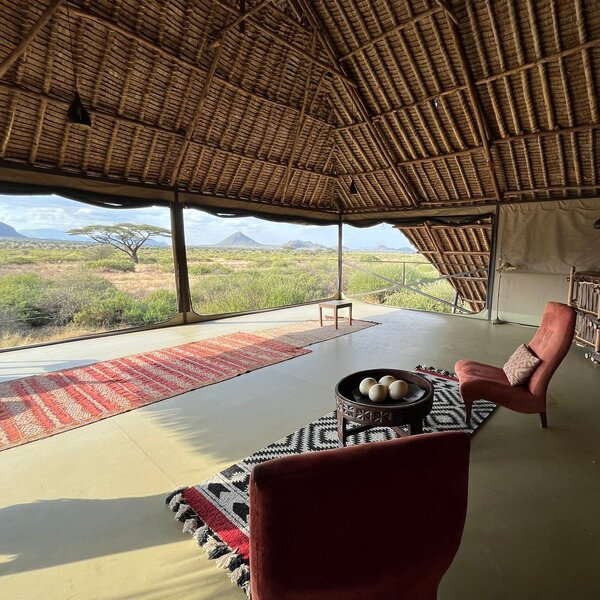
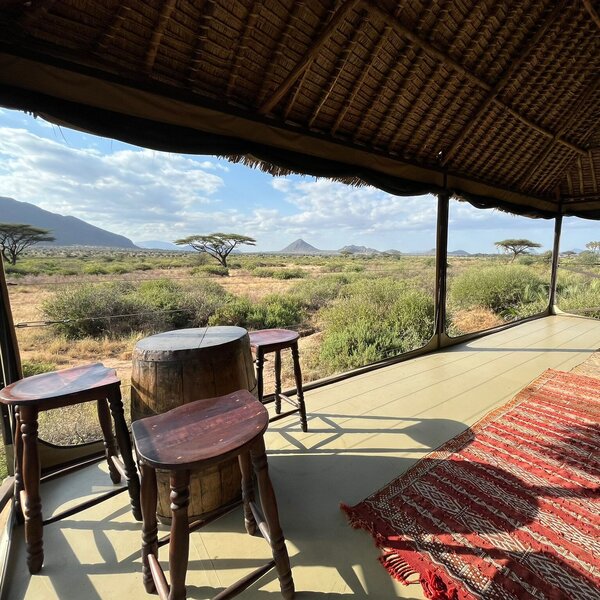
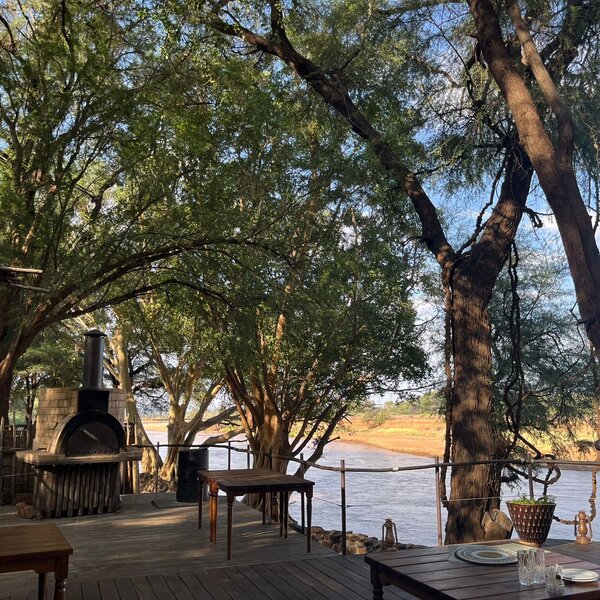
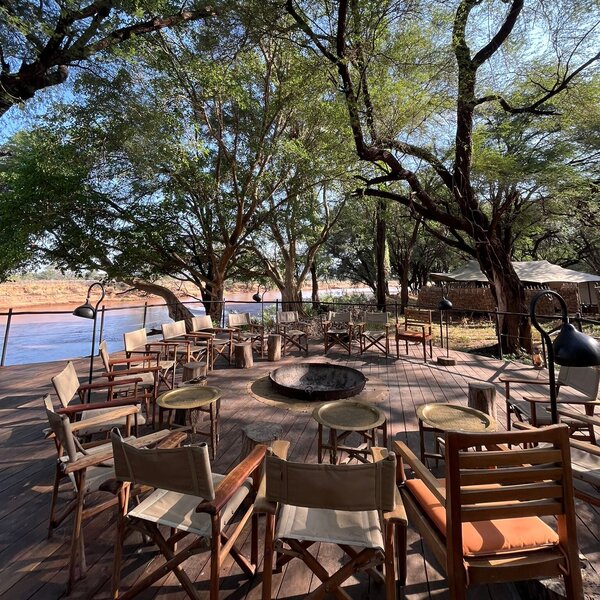
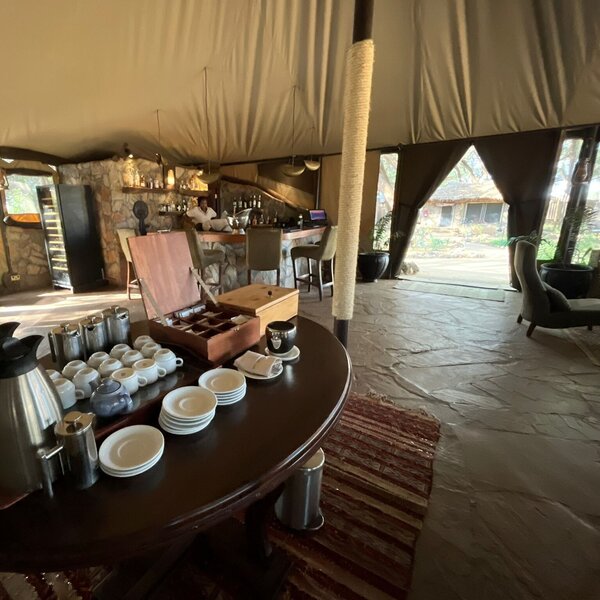
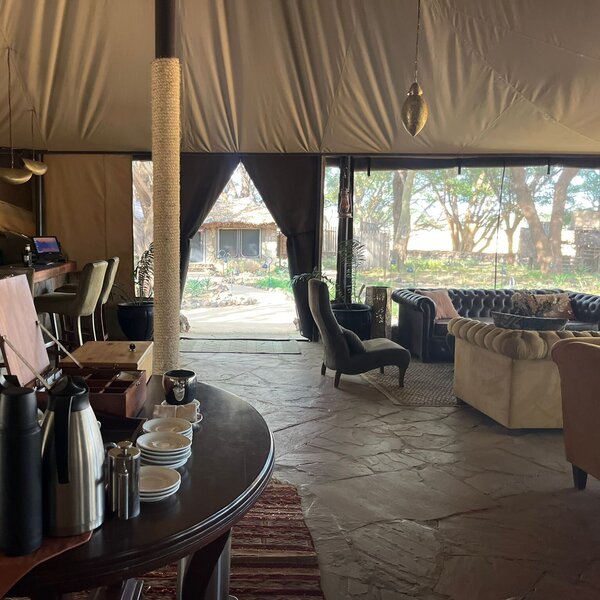
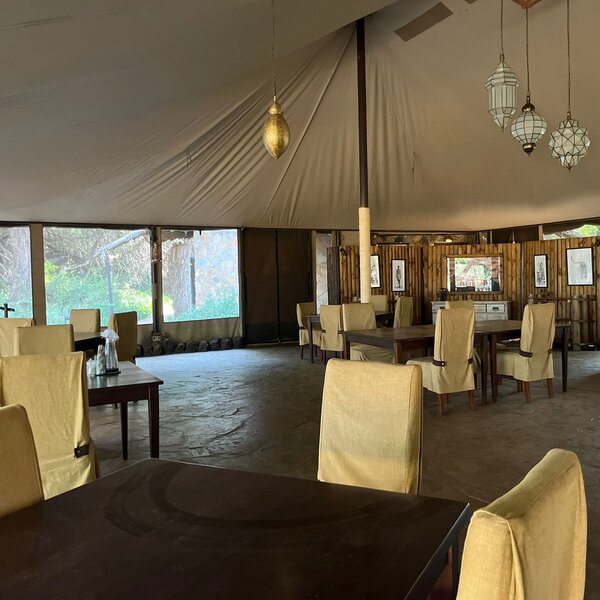
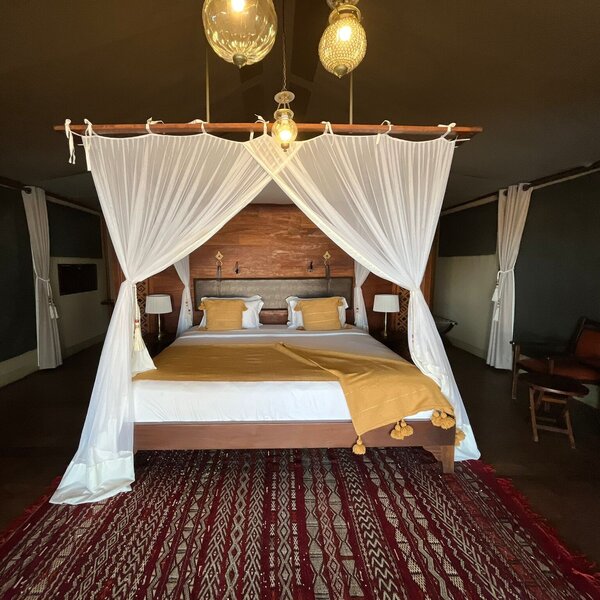
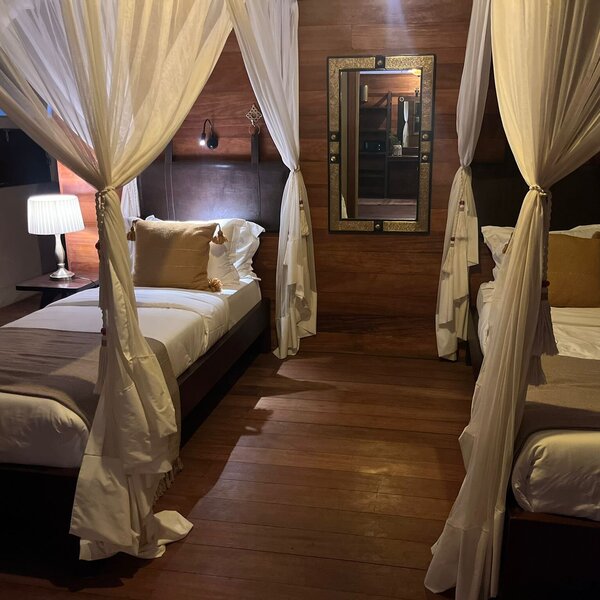
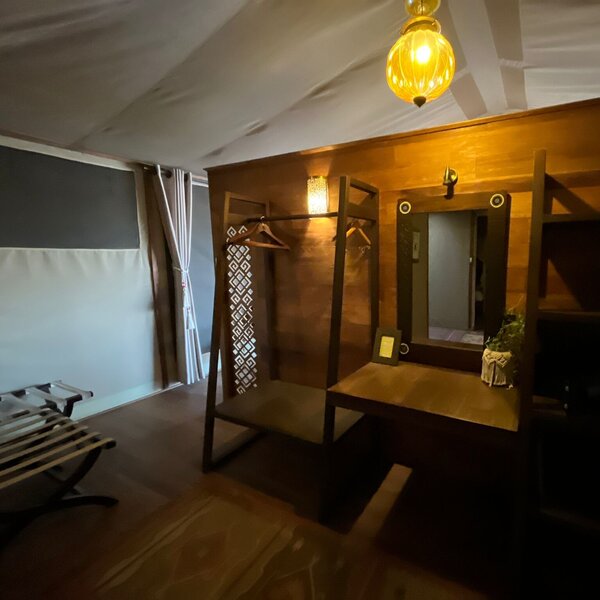
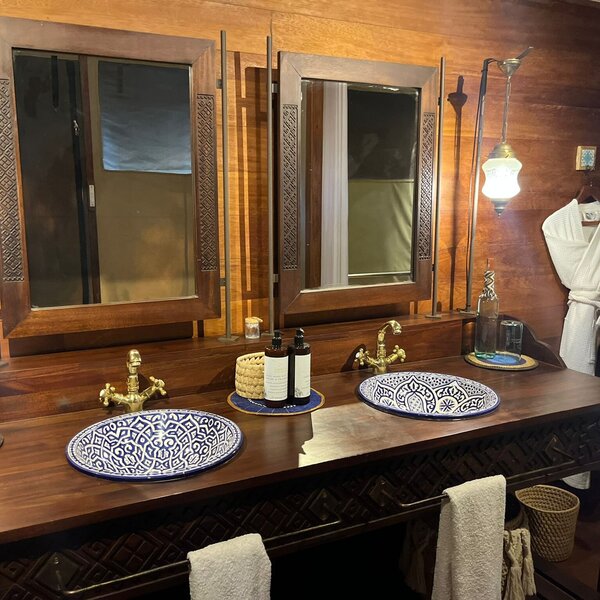
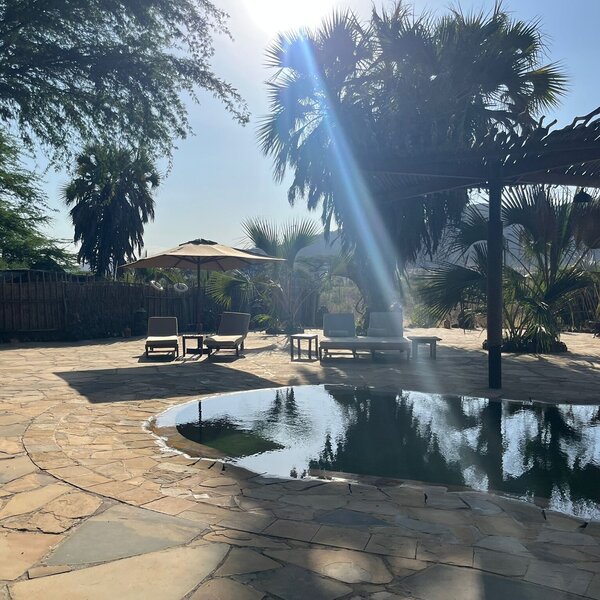
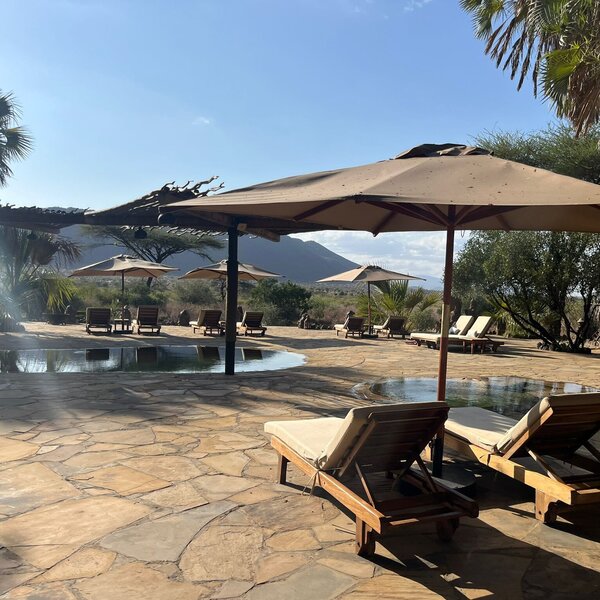
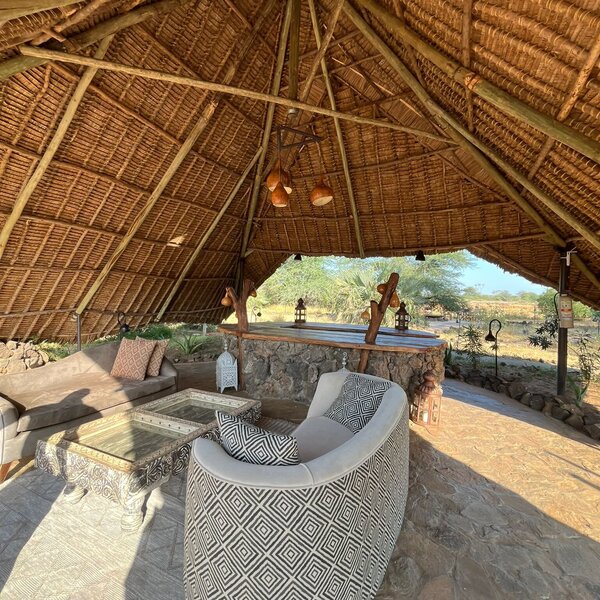
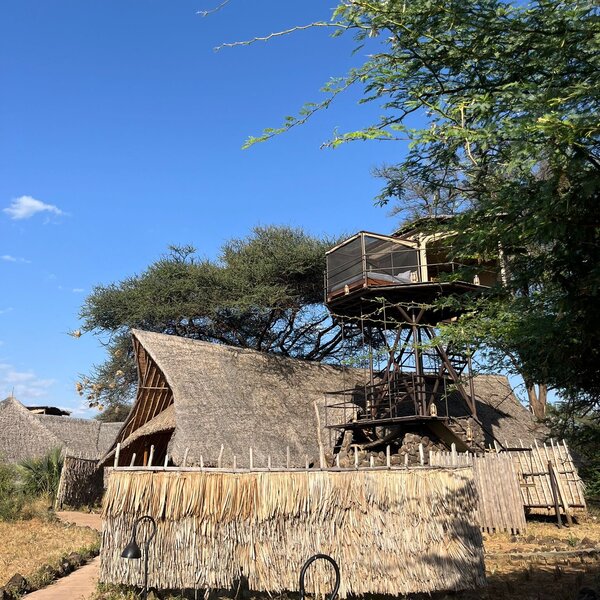
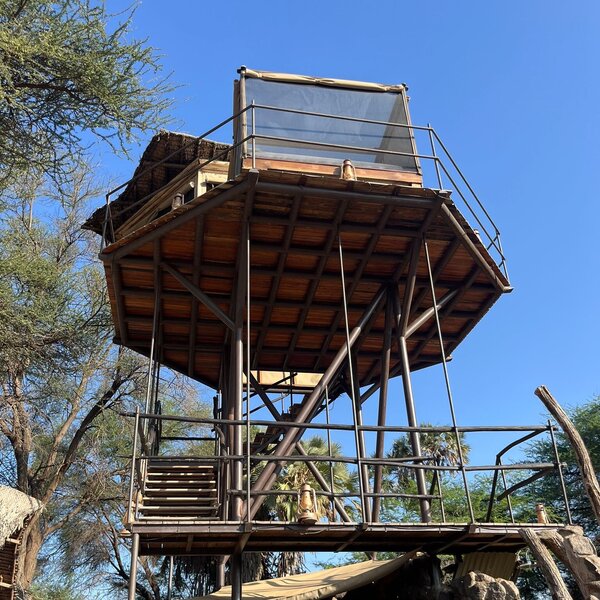
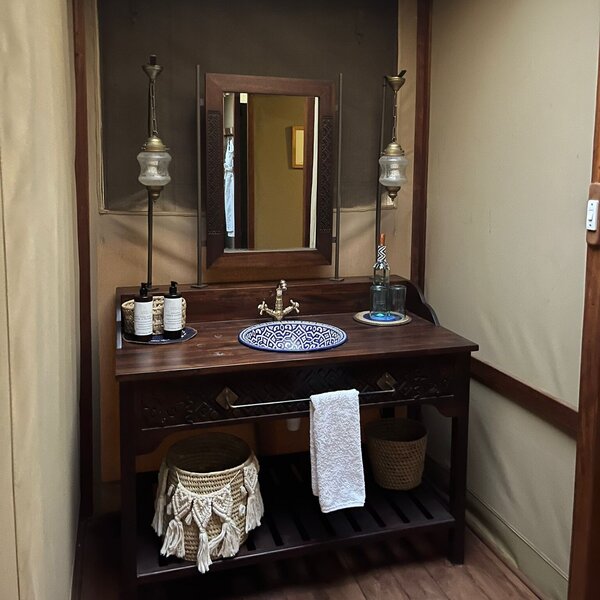
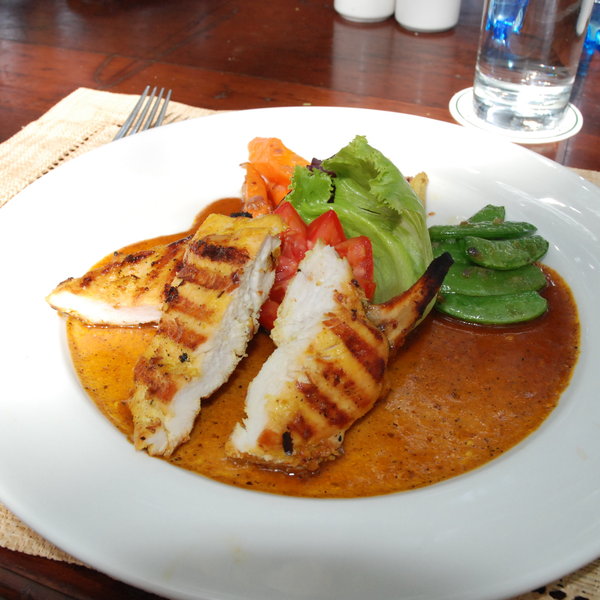
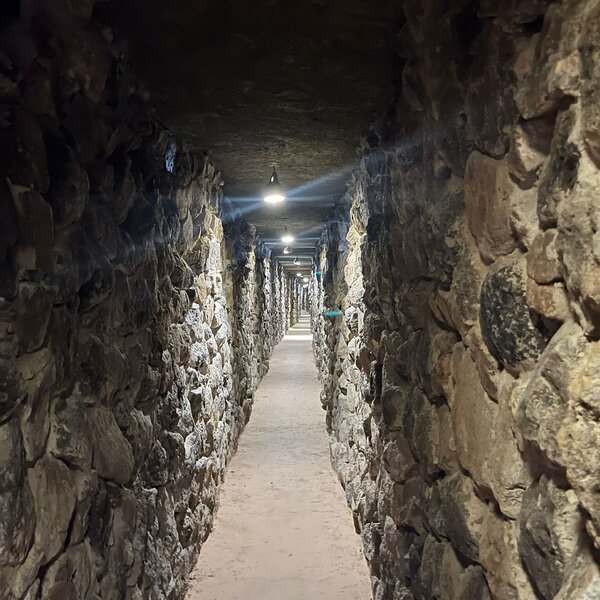
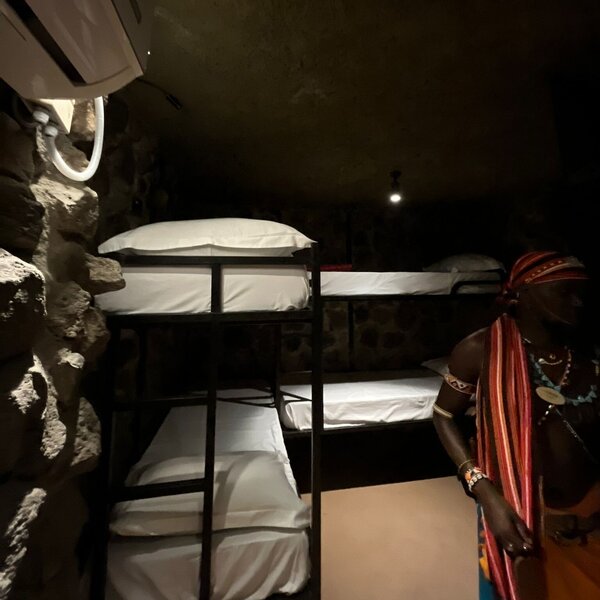
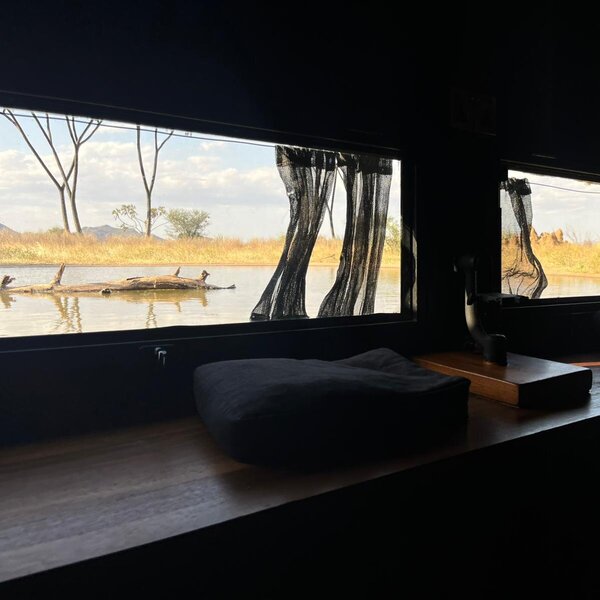
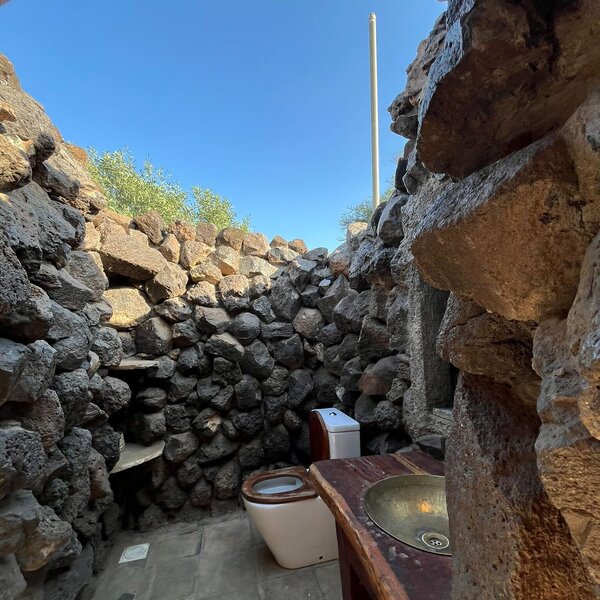
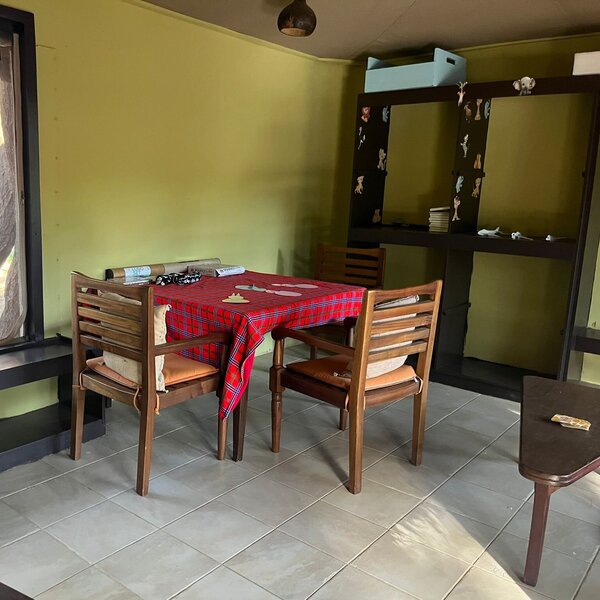
Expert Africa's gallery
When we travel we take lots of photos ourselves to give you a real and un-edited view of the safaris. See our 25 pictures of Larsens Tented Camp to get the candid view.
View galleryLarsens Tented Camp: Our full report
One of a handful of tented camps along the north bank of the Ewaso Nyiro river, Larsen's is well placed to ...
... provide reliably good game-viewing in the dry country of Samburu National Reserve.
Larsen's first opened in 1987 and is now part of the Soroi group of safari camps.
Having undergone a complete refurbishment, Larsen's Tented Camp now opens onto a dappled parking area. Upon arrival, you are taken to an open-fronted thatched building for your introductory briefing. Here, a noticeboard displays all of the activities available from Larsen's and you may be able to spot the tame baby impala that has made the camp its home.
A well-maintained stone path leads on from here, winding through tall fig and yellow-barked acacia trees towards the main front deck, raised on a wooden platform overlooking the Ewaso Nyiro river. En route to the deck, you'll pass the well-stocked reception and gift shop, as well as the Young Explorers' Club located next door. This is a designated play area for younger travellers, equipped with children's tables and chairs, games, and colouring equipment.
The main deck is a large wooden platform equipped with individual dining tables and chairs, where guests often enjoy their breakfast or lunch, all positioned to look out over the sandy riverbank and flowing water beyond. To one side is a sunken firepit encircled by director's chairs, where guests meet to swap stories over a pre-dinner drink, and at the other is a brick pizza oven that is regularly put to good use. The main restaurant, lounge, and bar area sits about 20m back from the river, one large open-plan tent with wide canvas doors, billowing cream canvas ceilings, and cool stone floors. To one side are dark wooden tables and chairs for dining, while the more relaxed lounge and bar area is on the other. Simple cream and leather sofas and chairs surround coffee tables dotted with interesting books, and the bar is well-stocked with a selection of drinks that are included in the rates (as well as some excluded specially imported ones).
The two family tents are the closest rooms to the left-hand side of the communal deck area, raised on concrete platforms with a good-sized outdoor deck. These rooms are stylish and simple, although relatively dark. A couple of leather-cushioned chairs sit against one wall, with a writing desk and chair located against the other. A deep red rug lines the floor, atop which sits a comfortable king-sized or twin beds. Both bedrooms have an ensuite bathroom equipped with beautifully tiled wash basins, complimentary robes, a flushing toilet, and hot water shower. They are divided by a central wardrobe and dressing area that houses a luggage rack, hanging space, and safe. This area can be sealed off, shutting the two ensuite bedrooms off from one another so the rooms can be used for individual bookings.
Six standard tents that can be configured as a double, twin, or triple are spread to either side of the main area, designed in the same style as the family units and including the same amenities such as a complimentary mini-bar and standing fan for warmer evenings. They are accessed via the stone pathway leading off from the reception area and, en route, you will also pass the camp's spa treatment room and crystal-clear pool, surrounded by lounge chairs and umbrellas. There is also a changing room and bar here.
At the farthest end of camp to the left-hand side of the communal area are two deluxe tents. These share a private entranceway and parking, communal area, and fire pit, and each comes with a private butler, vehicle and guide, plunge pool, and, most excitingly, a sleepout deck raised on platforms above the rooms. Larger in style and with the potential to remain completely separate from the rest of the camp, these rooms offer privacy and romance for couples or a great base for groups and families looking to enjoy a higher level of exclusivity.
Beyond these rooms at the very far end of camp is a further surprise: a wooden door that descends into a long, stone-walled tunnel. Light fixtures attached to the ceiling illuminate your way as the tunnel brings you to a small room equipped with two bunk beds and stocked with complimentary tea, coffee, and a mini-fridge. There is also a TV fitted to the wall that can livestream views of the waterhole beyond, a clue that this room is used as a base for the camp's photography hide. Indeed, the bunk room leads on to a second where comfortable high chairs sit before a raised wooden bench equipped with bean bags for propping up or steadying cameras. These look out at eye-level to the waterhole, where previous guests have enjoyed documenting everything from elephant herds to thirsty male leopards pausing to take a drink during their nocturnal wanderings. If you're a keen photographer, you are welcome to use the bunk room any night of your stay at no additional cost, and can wait comfortably thanks to the modern air-conditioning unit attached to the walls. The only potential downside lies in the loo's location, a little distance away from the bunk room and hide, back at the entrance of the underground tunnel.
Besides this cleverly designed hide, activities at Larsen's Tented Camp focus mainly on twice-daily safari drives which are led by very good and enthusiastic guides. On a previous visit, one drive we had was so interesting that it took us about an hour to go more than 200 yards up the road! The morning drive usually lasts from 6.30am to about 9.30am when you will return to camp for breakfast, then the afternoon drive is from 4.00pm until 6.30/7.00pm. Larsen's can also offer two-and-a-half-hour bush walks for US$50 per person, led by a guide and two armed rangers; wilderness breakfasts for US$75 per person; cultural visits to a local Samburu villages for US$50 per person; and full-day excursions to Reteti Elephant Sanctuary, located a 1.5hr drive from camp. Please reach out to your Expert Africa specialist to learn more.
When we last visited, sundowners were also set up on a second beautiful raised deck at the back of camp, or in the park itself, with a table, drinks and canapés.
Activities
4WD Safari
Birdwatching
Private activities
Families & children
- Attitude towards children
- With the Young Explorers' Club and two family-tents, Larsen's is happy to accept children of all ages.
- Property’s age restrictions
- No minimum age limit.
- Special activities & services
- Larsen’s Tented Camp has games available and can organise activities such as treasure hunts and bow and arrow making. They have a 'Young Explorer's Club' well-equipped with cards, stickers, game and colouring equipment. They will also arrange childminding, but only during dinner when parents are still in camp. Note that childminders are from the housekeeping or security staff, and not specially trained in childcare.
- Equipment
- Larsen’s Tented Camp has baby cots and highchairs.
- Generally recommended for children
- Larsen’s Tented Camp has an electric fence which, although not foolproof, largely prevents big game from wandering through the camp. This makes it safer than other camps in the area for children – although close supervision of them will still be needed. Further to that, the unpretentious vibe and fun staff would make children feel really welcome.
Food & drink
- Usual board basis
- Full Board & Activities
- Food quality
- We didn’t get a chance to try the food on our most recent visit, so the following comments are based on a previous visit.
Breakfast is continental and usually served as a buffet with cereals, fruit, juice, yoghurt, and a selection of freshly baked muffins and bread. If Larsen's Tented Camp is not full they will instead serve breakfast to your table.
Lunch is à la carte, with choices for each of the three courses. For a starter, we had the choice of salad or a gazpacho soup. The main course offered four choices: grilled chicken with an orange sauce, grilled fish, or lamb kebab with a mint sauce. All were served with vegetables, and rice or potatoes. Then dessert was a fresh fruit salad or black-forest cake, all rounded off by cheese and crackers.
Following a similar form, dinner was also à la carte. We had cucumber soup as a starter, grilled steak with peppercorn sauce and vegetables for the main course, then a crème brûlée – and we just about had room for cheese and crackers too. - Dining style
- Individual Tables
- Dining locations
- Indoor and Outdoor Dining
- Further dining info, including room service
- Larsen’s Tented Camp can serve dinner to your room or veranda at no extra charge. Private dining can also be arranged by the swimming pool.
- Drinks included
- Most drinks are included at Larsen’s Tented Camp apart from premium wines, champagne and imported sprits.
Getting there
- Location
- Samburu National Reserve, Kenya
- Ideal length of stay
- 3 nights
- Directions
- It is a 90-minute flight from Nairobi to Samburu, then usually a further 30-minute road transfer to the camp.
- Accessible by
- Fly-and-Transfer
Communications
- Power supply notes
- Laren's Camp now has 24/7 solar power with a backup generator.
- Communications
- Larsen’s Tented Camp has WiFi throughout the entire camp. Cellphone coverage is also good all over the camp.
- TV & radio
- There is a TV in the staff area that can be used by guests if specifically requested.
- Water supply
- Borehole
- Water supply notes
- There is plumbed in showers and toilets and hot and cold running water is available 24 hours a day. Please note that Samburu is a very dry area and guests are asked to keep water use to a minimum.
Health & safety
- Malarial protection recommended
- Yes
- Medical care
- An on-call doctor, who will come to Larsen’s, is based at Samburu Game Lodge, just 6km away. Three members of staff are first-aid trained and there is first-aid equipment at camp and in the vehicles.
Larsen’s Tented Camp has links to the flying-doctor service for any emergency cases. - Dangerous animals
- High Risk
- Security measures
- Larsen’s Tented Camp has a gate and electric fence, and their own security guards. They also have two armed rangers who are based at the camp.
- Fire safety
- There is a fire safety card in each room to tell you what to do in case of fire. Extinguishers are dotted around the camp and the team has regular training in their use.
Useful info
- Disabled access
- In Place
- Laundry facilities
- Laundry is included although for cultural reasons this does not include ladies' underwear, for which washing soap is provided in the rooms.
- Money
- Larsen’s Tented Camp can offer a currency exchange, but only up to a maximum of US$300 at any one time.
- Accepted payment on location
- It is possible to settle any extras at Larsen’s Tented Camp with Visa, MasterCard and Amex with no surcharges. They will also accept US dollars, euros, British pounds and Kenyan shillings in cash.
Plan and book your trip with Expert Africa
All of our trips are tailor-made, so we'll always adapt them to suit you. Talk to an Expert and let us plan and arrange your perfect trip.

Talk to an Expert
Call or email us now! We’ll match you with the Specialist in our team who is best suited to help you. Then together we can start planning your trip.

Set up your itinerary
Based on our experience and your ideas, your specialist will create a detailed, costed itinerary. We’ll refine it together, until we have a trip that you’re perfectly happy with.

Prepare for your trip
The same Specialist will make the seamless arrangements for your trip, send you detailed travel documents, and be available to answer any questions before you depart.

Travel with peace of mind
After you set off, you’ll be cared for by our partners in Africa, most of whom have worked with Expert Africa for decades. And if you ever need us urgently, we’re available 24/7.

When you return
We love to learn about your trip, and so will always be grateful if you’ve the time to give feedback to your Specialist when you return.
Larsens Tented Camp's location
Look closer at the environment and surroundings of Larsens Tented Camp.
Excursions from Larsens Tented Camp
Optional extra day-trips and excursions possible whilst you're staying at Larsens Tented Camp. Talk to us: these are usually best arranged before you go.
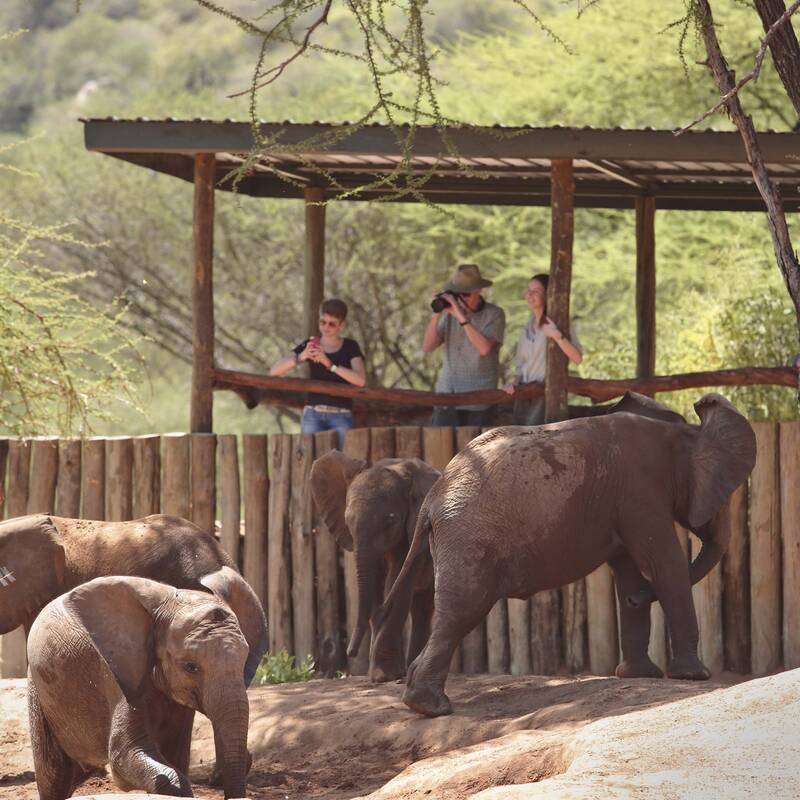
Reteti Elephant Orphanage visit
One-and-a-half hours, plus transfers
Visit the community-run Reteti Elephant Sanctuary in Samburu, for an intimate experience meeting the orphaned baby elephants who have been rescued from the surrounding regions. They are hand-reared by Samburu keepers, until they are ready to be released back into the wild.
More about Reteti Elephant OrphansOther lodges in Samburu National Reserve
Alternative places to stay in this same area.
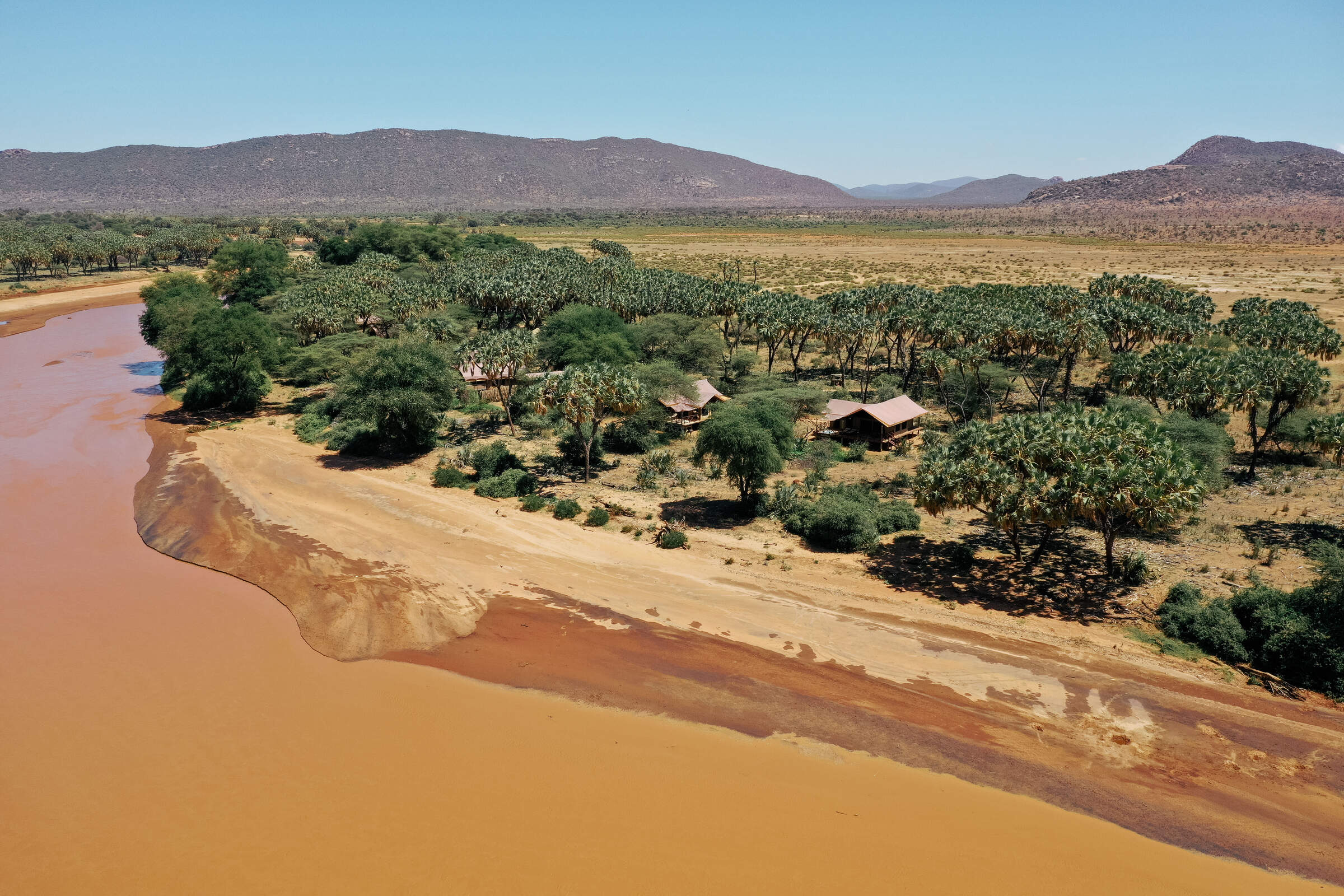
Elephant Bedroom
Elephant Bedroom is a smart tented camp in the heart of the Samburu National Reserve, offering a good degree of comfort without divorcing you from the beautiful natural environment.
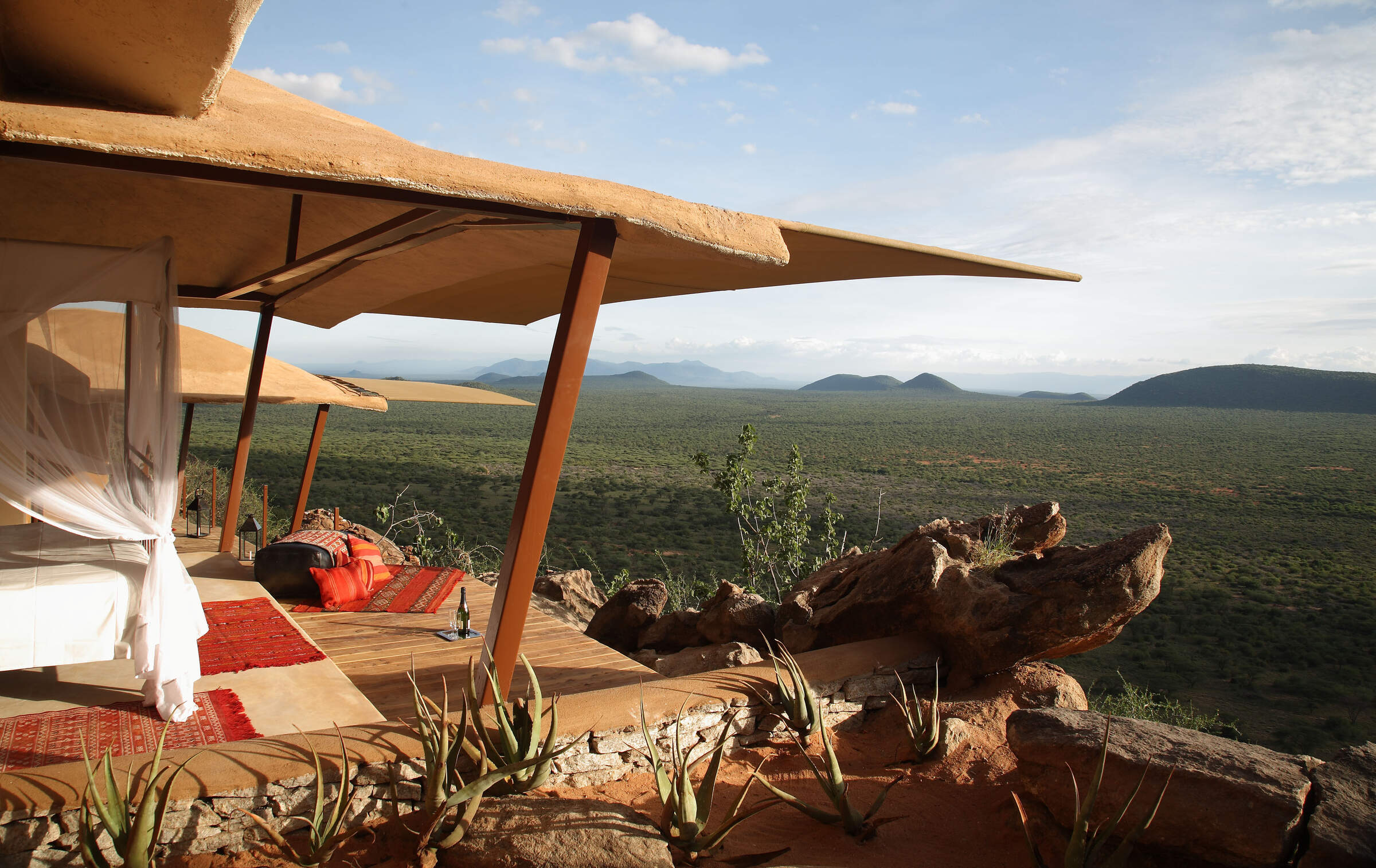
Saruni Samburu
Saruni Samburu is a top-quality boutique lodge, with one of the most breathtaking locations in Kenya overlooking its own private conservancy.
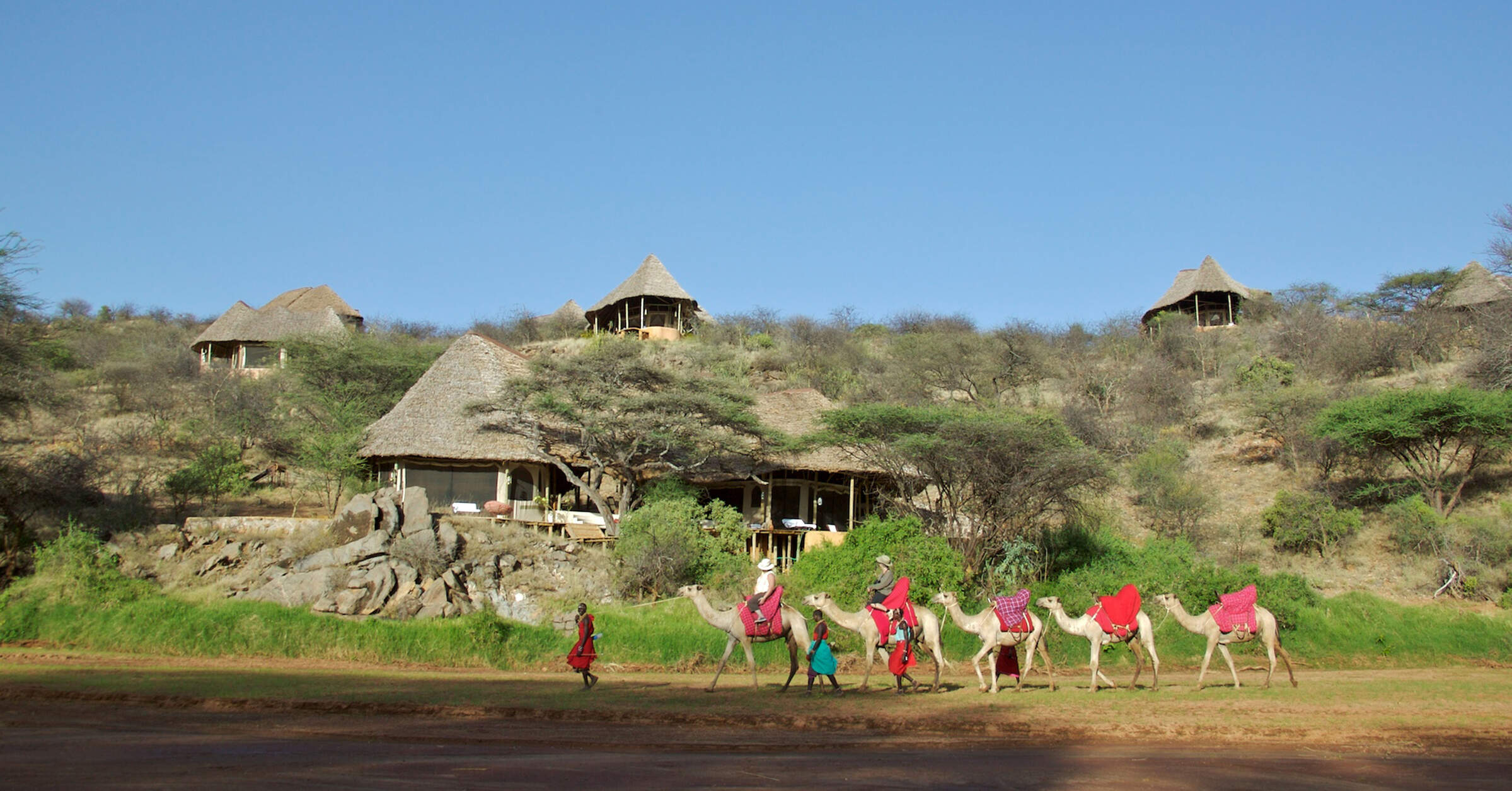
Sasaab
Stylish and luxurious Sasaab has nine rooms with stunning views across the Ewaso Nyiro River to the plains beyond.
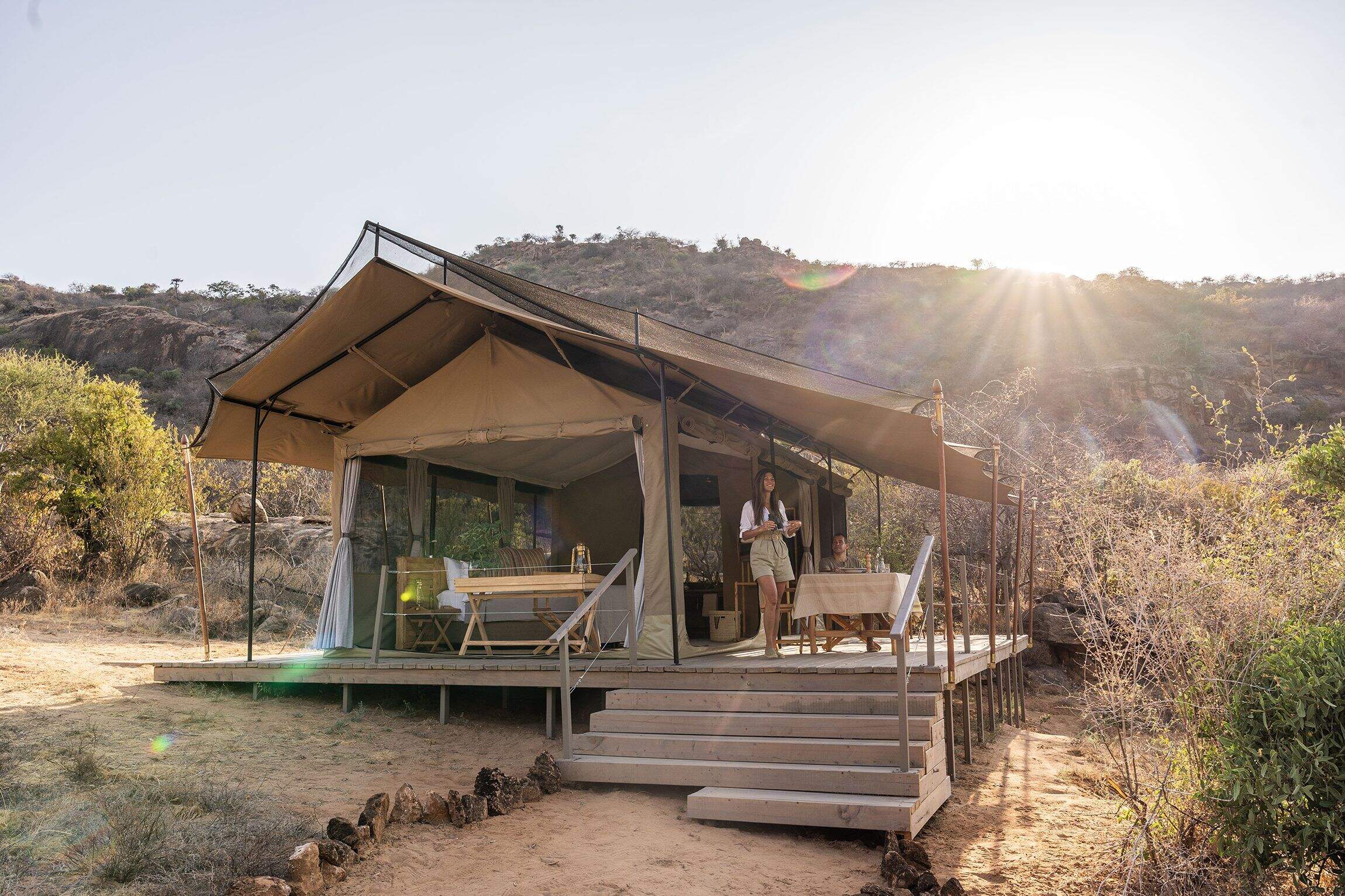
Basecamp Samburu
Basecamp Samburu is a smart tented camp offering an intimate safari within Samburu’s Kalama Conservancy and the surrounding reserve.
When to go to Samburu National Reserve
Our month by month guide: What it's like to visit Larsens Tented Camp in Samburu National Reserve
Jan
Feb
Mar
Apr
May
Jun
Jul
Aug
Sep
Oct
Nov
Dec
Kenya in January
Clear, hot days and warm nights make this high season a popular time for safaris and it’s also good for diving and snorkelling as water clarity is excellent and gets better as the dry season progresses. Most lodges and tented camps treat January after the New Year week is over, as mid-season, making it a good compromise in terms of value for money with reasonably reliable, dry weather and some greenery left in the landscape.
Expert Africa bases its description of climate and weather in January, like the other months of the year, on the climate records of roughly the last 100 years, and it's fair to say that the weather and seasons since the beginning of this century have been highly irregular and unpredictable.
- On average, January is the second driest month of the year
- Elephants dig waterholes in the dry riverbed in the Samburu reserve.
- Wildebeest and many antelope have their calving season, to February.
- Migrant birds are seen in huge numbers, especially in the Rift Valley.
- Sea water clarity around the coral reefs generally good.
Our view
Fantastic: the very best time to visit
Weather in January
Kenya in February
With the short dry season well established, the grass grazed down and wildlife gathering close to water points, this is still a good time for a safari. Good water clarity in the Indian Ocean's coastal waters makes for excellent diving and snorkelling conditions.
Expert Africa bases its description of climate and weather in February, like the other months of the year, on the climate records of roughly the last 100 years, and it's fair to say that the weather and seasons since the beginning of this century have been highly irregular and unpredictable.
- On average, February is the driest month of the year.
- It’s sometimes possible to swim with whale sharks at Diani Beach.
- Migrant birds are still seen everywhere, especially near water.
- This is usually peak calving season for wildebeest and many antelopes.
- This month is often the hottest of the year, especially on the coast.
Our view
A very good time to visit
Weather in February
Kenya in March
Hot, increasingly humid weather – with good diving and snorkelling conditions at the start of the month – gives way to rains and lower accommodation costs. Expert Africa bases its description of climate and weather in March, like the other months of the year, on the climate records of roughly the last 100 years, and predicting the seasons since the beginning of this century has been difficult.
March is the month when – traditionally – intensely hot conditions build up until a cloudburst finally happens at the end of the month or in early April, to relieve the humidity. As ever, regional variations across the country can greatly impact on visitors' experiences.
- Sea-water clarity is best for diving before the long rains start.
- Visitor numbers are low, though the Easter holidays can be busier.
- Night skies can be scintillatingly clear in early March.
- Cropped down savannah grasses can make it easier to see the wildlife.
- Temperartures climb high, especially at lower elevations.
Our view
A good time to visit, with pros & cons
Weather in March
Kenya in April
April sees the full onset of the southeast monsoon wind or kusi, which heralds the long rains. Temperatures drop soon after the rains are established and you’ll often have facilities largely to yourself in this more affordable low season, sometimes known as the "green season". The bush quickly springs to life, with greenery sprouting almost before your eyes. While you're likely to get a fair number of heavy showers, the breaks in the rain can yield sparklingly clear conditions.
With the dust settled and bright sun piercing the clouds, conditions can be sublime for photography, especially first thing in the morning or in the late afternoon with another storm brewing. You may be lucky, or you may find conditions very wet and muddy.
- A wet month, the coast often gets more than 300mm (12in) of rain.
- Sunny spells can provide great light for photography.
- Buffalo and zebra calving season often happens in this month.
- Baby crocodiles hatch, for example on Central Island in Lake Turkana.
- Palearctic migrant birds gather to fly north to breeding grounds.
Our view
A time to avoid if possible
Weather in April
Kenya in May
While game viewing can be trickier as vegetation runs riot, between the cloudbursts the colours and light are great for photography at this time of year. Expert Africa bases its description of climate and weather in May, like the other months of the year, on the climate records of roughly the last 100 years, and while it's reasonable to expect heavy rains in many parts during this month, especially on the coast, the rains don't always come evenly or in some areas come at all.
In an El Niño year, the so-called long rains that normally are established across much of the country by May can be meagre, to the despair of farmers. On the other hand in a La Niña year, the long rains can bring floods. On the coast, the monsoon winds make the climate much more predictable, with heavy rains common throughout this month.
- Frogs breed in the ponds in the Arabuko Sokoke Forest near Watamu.
- Wildebeest, impala and other grazers are in rut (the breeding season).
- Kilimanjaro looks its best as heavy rain falls as snow on the summit.
- There's a sharp peek of rainfall on the coast with many rainy days.
- Accommodation prices are uniformly low, while some camps close.
Our view
A time to avoid if possible
Weather in May
Kenya in June
The rains give way to cloudy, cooler weather, often making for comfortable conditions by the end of the month, especially in the highlands. Starting from mid-June or the beginning of July and running until the end of October, this is the high season, and accordingly has higher accommodation rates and – at least until early September – higher numbers of visitors.
While the early part of June can often be rainy on the coast, it can be a great time to go on safari, with fresh greenery, many young animals and good photographic conditions with clear air.
- The Taru Desert, inland from the coast, is carpeted with flowers.
- The Lake Turkana Cultural Festival is held in Loiyangalani.
- Madaraka Day (commemorating self rule) is 1 June.
- The annual Lewa marathon runs a course through the wildlife.
- The Diani Rules "sports" event rips up the rulebook at Diani Beach.
Our view
A good time to visit, with pros & cons
Weather in June
Kenya in July
Kenya’s “winter" season sets in (winter is a misnomer but locals feel the change), and the highlands can be rather grey. Skies are often cloudy and the days can be surprisingly cool, with an average daytime high in many highland safari areas of 15-20°C and night-time temperatures dropping below 10°C in Nairobi and the highlands. Lower parts of the country and the coast are usually warm and dry, typically reaching highs of around 25°C with lows in the high teens.
As this is the start of the high season, coinciding with the usual arrival of the wildebeest migration in the Maasai Mara, July is a busy month. Ask your Expert Africa specialist to advise on how to avoid the crowds, which is not that difficult to do.
- The wildebeest migration usually reaches the Maasai Mara in July.
- Simbi Lake (Kisumu) and Crater Lake (Naivasha) can attract flamingoes.
- Watersports start to pick up and some surfing is possible at Malindi.
- Afternoon thunderstorms are a common feature in the Maasai Mara.
- The sea can be choppy along the coast, making diving difficult.
Our view
A good time to visit, with pros & cons
Weather in July
Kenya in August
The Great Migration fills the plains of the Maasai Mara, and school’s out, so the park roads are full of tourists – ask your Expert Africa specialist for advice on crowd avoidance tactics. Choose a private conservancy rather than a public national park or national reserve for quieter conditions.
Like July, August is generally mild and relatively dry in the safari areas, but it can be very chilly in the highlands, even in the middle of the day, and hail occasionally falls above altitudes of around 2,400m (8,000ft). Nairobi can be disappointingly overcast, with low cloud.
- Apart from Christmas holidays, this is the busiest month of the year.
- Late August sees peak wildebeest drama at the Mara River crossings.
- Coastal winds are good for kite- and wind-surfing.
- Few mosquitoes are around at this generally dry time of year.
- The annual Camel Derby takes place in the Samburu capital, Maralal.
Our view
A good time to visit, with pros & cons
Weather in August
Kenya in September
The skies clearing of cloud signals the start of hot, dry weather with little chance of rain – and, after the first few days of the month, far fewer visitors – making the latter part of September a good time for a quieter safari. While early September is often good for dramatic migration crossings along the Mara River, you might consider deliberately postponing your trip until later in the month, when the migration can still be very impressive and visitor numbers fewer.
If tourist surges are somewhat predictable, however, the patterns of the wildebeest migration are more volatile, and like all of Expert Africa's climate and weather assessments, they are based on accumulated years of experience rather than guaranteed certainty.
- This is still high season, with prices to match.
- Many river crossings take place on the Mara river in both directions.
- Natural bush fires flush out insects and small animals for predators.
- The Rift Valley Music Festival takes place by Lake Naivasha.
- With school holidays over by early September, late-month is quieter.
Our view
Fantastic: the very best time to visit
Weather in September
Kenya in October
Still hot, mostly dry and not too busy, this is many people’s preferred month for a safari, and it’s also good for diving and snorkelling. The wildebeest and zebra herds of the great migration are often still to be seen, though in dwindling numbers. The swamps of Amboseli attract thirsty wildlife including large herds of elephants.
While we wouldn't expect much rain across most of the country this month, the climate has become so unpredictable that you can never say never, and the possibiity of the short rains – usually associated with November to mid-December, starting early, can't be discounted.
- This month sees the tail end of the great migration in the Mara.
- Palearctic migrant birds start to arrive, staying until March.
- Turtle nests hatch at Watamu, until November.
- Amboseli elephants focus on the swamps for their daily water.
- The Indian Ocean monsoon winds turn from southeast to northeast.
Our view
A very good time to visit
Weather in October
Kenya in November
The northeast monsoon wind or kaskazi heralds the start of the “short rains", usually some time in the second half of the month. From November to mid-December, this is the low season, and accordingly has lower accommodation rates and lower visitor numbers. Across most of the country you can expect warm, somewhat cloudy weather, with occasional heavy showers and localised flooding.
Expert Africa bases its description of the climate in November, like the other months of the year, on the records of roughly the last 100 years, and it's fair to say that the seasons since the beginning of this century have been highly irregular and unpredictable: some years the short rains don't come at all, or don't reach every part of the country. In an El Niño year, the November short rains can be very heavy, but in a La Niña year, they can fail completely.
- Swimming with dolphins in Lamu can be done from now until April.
- Birders gather at Ngulia in Tsavo West to ring Palearctic migrants.
- The Lamu Cultural Festival takes over the town and Lamu Creek.
- Agricultural shows often take place regional market towns.
- This is low season, so camps can be great value, with special offers.
Our view
A good time to visit, with pros & cons
Weather in November
Kenya in December
In a typical December, the rains usually finish by middle of the month, leaving the landscape looking its best, under clear blue skies, and heralding the start of the second peak tourist season from around 20 December to the first week of January. Our assessment of the likely weather in December, like the other months of the year, is based on climate records, and it's fair to say that the seasons since the beginning of this century have been highly irregular and unpredictable.
Christmas can sometimes be wet, but most years the rains have finished a week or two earlier, with the festive season ushering in the perfect combination of clear skies and sunshine by day and starry nights.
- Christmas and New Year are busy, with the lodges and camps full.
- Rates are highest after 24 Dec, with supplements on public holidays.
- Republic Day and Independence day are celebrated on 12 December.
- Good kite- and wind-surfing restarts, with strong northeasterly winds.
- Mango season begins, providing excitement for primates and elephants.
Our view
A good time to visit, with pros & cons
Weather in December

Looking for inspiration on where to travel next?
Visit our trip chooser to explore your options and find inspiration for your perfect African adventure
Inspire me